PHANTOM THREAD Q&A With Paul Thomas Anderson
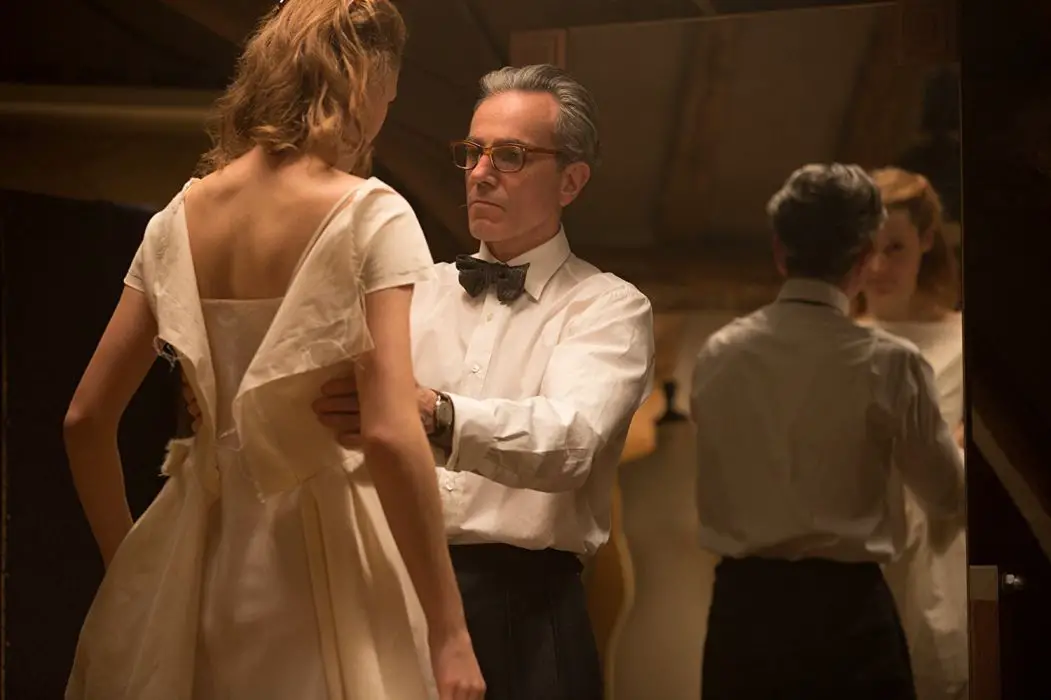
Alex Arabian is a freelance film journalist and filmmaker. His…
Acclaimed filmmaker Paul Thomas Anderson presented his latest film, Phantom Thread, on January 4, 2018 to members of SFFilm (the organization responsible for the San Francisco International Film Festival) at the famous Castro Theater, an event sponsored by both SFFilm and The New York Times. Anderson has screened four of his eight feature films at the Castro Theater, but the Q&A after Phantom Thread was his first. The event was moderated by long time SFFilm staff member Eric, who is an avid Anderson fan.
During the conversion, Anderson discussed aesthetic influences, real-world and filmmaker inspirations behind the making of Phantom Thread including various famous fashion designers and obscure, classic films, his old school style of filmmaking, what it’s like working with frequent collaborator Jonny Greenwood of Radiohead, and pleasures of directing such a singular talent like Daniel Day-Lewis, particularly on the actor’s last film before retiring from the craft.
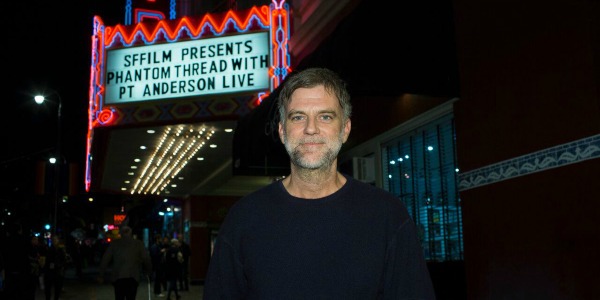
Eric: [applause] Hello. I’m Eric. I’ve been working here for the past 15 years, and what was established earlier was that these Castro screenings have become a tradition. And was anyone here for the There Will Be Blood screening in 2007? [applause] Look, that screening ruffled some feathers. That movie was shown weeks, if not months before its official release. It ruffled a lot of feathers, tickets were sold, that money had to be converted into donations to the John Burton Foundation, which the owner of this theater still gets requests for donations to this day. So, knowing that, carrying on, this is the fourth screening and first Q&A: Paul Thomas Anderson [applause], Paul Thomas Anderson [applause] [clapping]. Welcome back.
Paul Thomas Anderson: And the same to you.
Eric: Good job. There Will Be Blood, that movie was dedicated to Robert Altman. This was dedicated to Jonathan Demme.
Paul Thomas Anderson: Right. Well, yeah. Jonathan was a very good friend of mine, a hero of mine growing up. I loved his films, continue to love his films, and about three days before we finished shooting, I got a phone call from his partner Gary Goetzman saying that Jonathan was really sick. And on the last day of shooting when we see Alma pushing the baby carriage in the park there – just before that I got a call that Jonathan had passed away. So, I was kind of ultimately, incredibly sad, but then I heard his voice ringing around in my mind going, “Buddy, you finished your movie.” He was very enthusiastic to anybody who knew him.
So, he was the filmmaker that made me feel like anything was possible. Look, I mean anything is possible like it was – that you could make a movie the way that his films looked and felt and were so handmade. He meant a lot to me as a filmmaker and even more as a person, so, it’s great that we got to – It’s terrible that he died, great that we got to dedicate the movie to him. I miss him. [laughter]
Paul Thomas Anderson: I miss him too, and Robert Altman.
Paul Thomas Anderson: And Robert Altman, Well Robert yeah, Bob…we couldn’t believe Bob was still alive, you know? [laughter] He was supposed to have been dead like 10 times over by the time he finally keeled over. That was a shock. We thought he would never die. [laughter] He was so indestructible.
He had, like, spare parts – he was having spare parts and like new knees, new hearts, new this, new that. He was just kind of – I got a chance to work with him as a standby director on his last film, Prairie Home Companion, where he would go to chemotherapy and radiation on Friday so he could deal with that over the weekend and show up to work before anybody else on Monday morning. I mean, I was there just in case he keeled over or something happened, which I just sat in a chair behind him the whole time watching him. I mean he was a great friend, a good mentor – great mentor and yeah, I miss him a lot.
Eric: Okay, well, on to the film. Well, let’s just start at the beginning. How did this one come about? [laughter]
Paul Thomas Anderson: [Is that] Tom Snyder or something like that? [Referring to his style of speaking]
Eric: I’ll take that as a compliment.
Paul Thomas Anderson: This film came about a few years ago. I wanted to find a way to work with Daniel again, and I wanted to make a – I’m an aficionado of the adopted romance genre, which I’m sure you show a lot of here starting with Rebecca, Gaslight, Suspicion, all those ones that we all know and love. Those are the ones that I always gravitate towards. And so I had an idea that started with a very strong-willed man who was ill, and how nice he became when he was ill, and his spouse thinking, “Mhm, I kinda like him when he’s like this.” [laughter]
And that was enough to get started, to start writing this story, and that was a – we needed a job for this character to do and we both discovered some interesting designers: Cristóbal Balenciaga, who was a great Basque designer who worked in Paris in the ’50s. Charles James was another one – great American man and/British designer who worked kind of all over the place.
But they’re very interesting, self-obsessed, preoccupied with their work, demanding men, and that seemed a great venue for a story like this – for a kind of gothic romance story like this with beautiful dresses and women in lab coats and that kind of thing. So, that’s kind of –
Eric: Where else did this story come from?
Paul Thomas Anderson: I could keep babbling on. Well, that was the start.
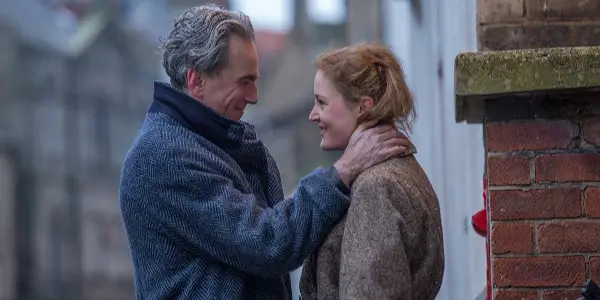
Eric: Well, here comes Mark Bridges.
Paul Thomas Anderson: Yeah.
Eric: He’s done all your movies? Costume Designer for all your movies?
Paul Thomas Anderson: That’s right, and he was very excited because normally our costumes are like, you know, jeans, t-shirts, that kind of stuff. And he got to say things like…I actually overheard him once in a costume fitting saying, “Let’s order it in cashmere from Paris.” And I kind of heard it and I started twitching. I said, “Did he really just say the word ‘cashmere?’” Yeah, he had a budget that would choke a horse on this movie. [laughter]
Eric: Well, you have his costumes integrated and I mean…whenever I watch your movies, I definitely quite easily get lost in the fact that I’m watching a movie. I mean, a lot of movies that I watch now are kind of – when they’re beamed on the screen, they’re beaming back at me a little too bright, a little too sharp, and it’s very distracting to me, personally, that’s just my thing. But when I watch your movies, there is this new kind of…I don’t know how it was created, but you have – you know, watching Daniel Day-Lewis’s hair against floral wallpaper, and indeed when he orders that gigantic breakfast in that scene, when you see the Lesley Manville’s eyes against…[loses train of thought] So, in this day and age, in this 21st century where all this stuff is possible after the movie is shot and it’s all done, how much of this were you able to just get on set, in camera, and not have to tinker with it later?
Paul Thomas Anderson: That’s a great question. The goal is always to come away from a day’s work and feel like you have it all, and it is very unsatisfying to feel like you don’t. And that happens from time to time where we’ll cheat a little bit here and there, but I’d like to think that our rule of thumb that we try to stick to is – it’s simply old-fashioned. The era that I started with when we shot on film, we printed on film, we watched our film daily’s and we learned to light pathways, so there was very few digital tricks and that kind of stuff that we used. I also started in a low-budget realm where I didn’t have money for sets and anything like that. And I figure, “Well, what do I have. Well, I got good actors.” So, light them really well and see their faces and no one will notice that you don’t have anything else because they are great, you know?
So, that has stuck with me, and Lesley Manville is somebody in particular who, when lighting Lesley Manville, you even have the light meter on and you realize that her face is a stop and a half brighter than anybody else’s, and in the movie you just take advantage of that, you find ways to light her. And she’s got these eyes that can pierce the Castro Theater; she’s really dynamic. So, we really try very hard to do everything on set and in camera. It’s a satisfying way to work so you kind of know when you’re watching daily’s the next day or that night and you feel like, “Oh, we’ve got it.” Or, “I don’t have it,” which happens quite often as well. And then you go back to the drawing board and shoot something again or figure out how to make it work. I hope that answers your question.
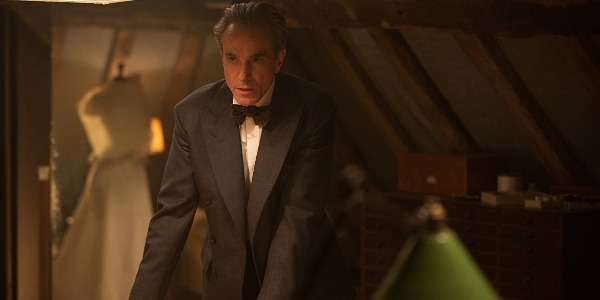
Eric: Yeah, I think. [laughter] Well, what’s next here…cast, the cast you’ve assembled.
Paul Thomas Anderson: Cast?
Eric: Yes, you have these two fantastic women, very powerful women who – what I take away from this movie is that you have this genius designer and his support system are these two women: one that’s been with him who’s a constant, and then a new woman in his life, and when he doesn’t recognize that these two women have dedicated their lives to him, when he doesn’t recognize that, they have their own special way of putting him in his place and saying – I also like to think that if you want to call it genius, whatever, talent – any talent by an individual needs a support system, cannot exist in a vacuum.
Paul Thomas Anderson: Right. Well, you should see – one of the most famous designers, the name we still all know, Christian Dior – there is a fantastic photograph of Christian Dior. This is the 50s, the early 50s in Paris and he’s this little chubby Frenchman, and he’s standing at the front of in between three to four hundred women in white lab coats, and they’re all behind him and he’s the only man. There’s maybe one other guy in accounting, who’s like in the far-right [laughter], you can kinda barely see his head poking through through. But that was and continues to sort of be the reality of the fashion world today, then and now, is these kind of slightly tyrannical, slightly fascist men, leading this talented group of women who are behind the scenes like mice doing everything for this master.
What we tried to do, we patterned our character off Balenciaga. When he would get very frustrated, he was able to grab a garment and do something himself. Many designers even today can barely sew. They have ideas and they have sketches or something like that. But the idea of having a sister, which, by the way, is also a very common thing in people of this period; ironically, we were writing this story and we found out what we were writing was very true, that there’s usually a serious mother fixation and usually there was a sister that ran the place, we just happened to get that right.
There was usually the son who was kind of idolized by the mother, taught his trade by the mother, and the sister would be marginalized in a way to make sure that the brother was always held up so that his feet didn’t touch the ground, so that he was able to work and be sheltered from any outside distractions. And this would create a situation where he absolutely lives in a bubble. He’s like a baby, you give them anything that they want. That’s a very good dramatic dynamic to come in and throw a stink bomb into just to see what happens if you throw a scorpion in the middle of them.
So, when you have Alma come in with this terrific actress that I mentioned before, Vicky Krieps, where no one is showing her the ropes and no one is helping her out, how does she figure out to show this fool what was right in front of his face which is a tremendous amount of love and affection and support, but he’s just got to be smart enough to realize that. Am I babbling on again?
Eric: Jonny Greenwood [laughter]. His score, it’s perfectly integrated into the movie, it just floats through the movie, the movie floats through the score and it’s like, “You could’ve come first or you could’ve come after it.”
Paul Thomas Anderson: Uh huh, yeah. Well, and that’s good. Jonny Greenwood, as anybody maybe knows, he’s from Radiohead, and we’ve done four or five movies together now. And we started working together very early on. I’ll tell him what I’m writing and I’ll show him all the research material and I’ll share the script with him and I’ll share the daily’s with him. So, he is constantly writing music through that process, so I have music that I’m writing through.
So, it’s plotted out a bit like you would in a musical – nobody’s singing and dancing, but that kind of whole thing was sort of plotted like it’s dependent upon the music; they go hand-in-hand. He’s a great collaborator. You never have to beg him for more music, you have to kind of tell him to politely stop sending music. He’s just like a faucet that it just comes out of him. And some of the stuff is left over from past films that we’ve done, it didn’t really work out, and that film, there were new ideas…that kind of thing.
He’s a great, great collaborator, and the only thing that I told him on this film was, these things are sort of more atonal and and I gave him American lush music like, um, Billy Strayhorn and Nelson Riddle. I gave him a bunch of Nelson Riddle and I said, “Come on, let’s nail some Nelson Riddle. Let’s make it feel romantic.” He’s very English, he’s not very romantic, so, if anything, very English and romantic at the same time. I also sent him a great movie called The Passionate Friends by David Lean, which most people don’t know because they know the movie before which was Brief Encounter, which we all know. But right after that, he made a terrific movie, little seen, called The Passionate Friends, which I highly recommend, which is a fantastic score, by who I’m blanking on the name. I’m sorry about that. But that’s how that relationship works, it’s great.
It’s one of the best feelings in the world for me directing a movie over the course of a year, because of the time change, waking up in the morning and looking in my inbox and saying, “Oh, Jonny sent me something new today,” you know? I can’t tell you the pleasure that I get waiting for something to download, like, “Ah, I got new music today.” It’s a great feeling.
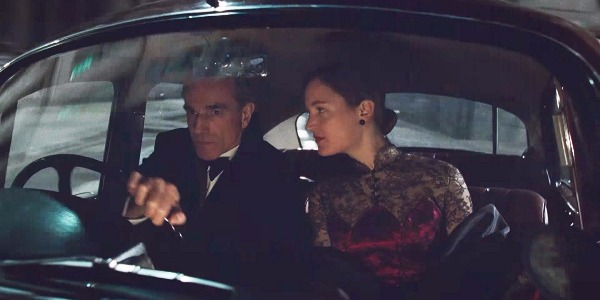
Eric: I’ve seen this movie now three times. So, the first time I watched the movie, I’m wondering, “What is Daniel Day-Lewis gonna do now?” And it’s happening before my eyes, second after second. Then, the second time I’m watching it, I’m thinking, “No, this can’t be the end. This can’t stop.” And so, when you were making this movie, did he tell everybody, “Hey, man, after this, I’m done.” Did he say that, or what?
Paul Thomas Anderson: Yeah, he just dropped his microphone at the end and said, (middle finger gesture) “See ya, f*ckers.” [laughter] No, his decision was made after the film, which I guess the implication there it is…[laughter] that he had the best time of his life. [laughter] That he doesn’t want to try and top it. I would think it was that. There’s a war, but I don’t think it was that. I like to think that – selfishly, who doesn’t want to see another Daniel Day-Lewis performance? And it’s a little bit hard to reckon with that right now. I feel like retirement announcements are made to be broken, so hopefully – maybe that’s the case here. But if it’s not, I think we should just be f*cking god damn happy with what we got. [applause] [clapping] Listen, I got to do it twice, twice, which is amazing.
Eric: What was that movie you wanted to talk about?
Paul Thomas Anderson: Oh, you know, one of Daniel and I’s favorite films is called I Know Where I’m Going! I don’t know if anybody’s – yeah! [clapping] Applause bigger than I thought it would be. It’s a Powell–Pressburger movie that was shot during the war up in Hebrides. It’s fantastic, and I don’t know how much it shares in common with us. It’s got a great female lead, and she’s kind of off, she’s off up north out of London and it’s just a great film. It’s a Powell–Pressburger movie. Where it falls in their scheme of things, I’m not really quite sure, but they shot a lot of it as the war was going on like in ’42? ’41, ’42? And it’s not to be missed.
We were looking at some lobby cards and stuff you’ve got coming up, A Matter Of Life And Death and Black Narcissus and that. So, The Red Shoes was another one that Daniel and I got into that you can see some similarities I think between him and Anton Walbrook. There certainly is a similarity in that hair, that fantastic hair. I remember he once told me that his father had hair like that. It was always so perfectly groomed and he never realizes, boy, just how long his dad’s hair was, and so they went into the ocean one day, and he sort of came up and realized his hair was like down to here. It was just like completely wild and he needs that much length on top to get it to really comb and sit back like that. So, it’s a nice touch, it’s very similar to Anton Walbrook’s hair, so, um, I could talk about hair forever if you have a lot of time. [laughter]
Eric: Go for it.
Paul Thomas Anderson: I’ll tell you another obsessions about hair was hair dye. Apparently, like we tried to do it, I don’t know how well we did it, but the hair dye for women in the fifties was basically like – and modern hair dye is just like they know, you can get multiple colors within one box let’s say – but back in the fifties, it was like, black, blue, brown. And it’s always a frustration point when I see films sort of set in a period like that, and the dye jobs are just a little too good, and t’s a little frustrating to me. I don’t want to name any names, but some things I see… [laughter] “I know for a fact that that’s not how hair dies -” they were kind of cancerous, one color. So, we tried to do a little of that in the film without seeming over the top, so, these are the kinds of things you think about when you are making a period piece. [laughter]
Eric: When you were preparing for this movie, were there movies that you would show to people saying, “This is want I want?”
Paul Thomas Anderson: The Passionate Friends was definitely one, I Know Where I’m Going! I personally did like a little – I saw Rear Window again as I was writing the movie, which I know really well, but sometimes you see things through a different lens. I mean, you saw a movie 5 or 10 years ago, and then you come to it and it just speaks to you in a different way. And Rear Window really spoke to me, particularly Grace Kelly’s performance and the sort of whole idea that Jimmy Stewart was this bachelor who would never get married and he’s a single guy and I’m a photographer and “I’m out there in the jungle and you don’t want any part of this,” and that kind of thing.
And this thrill that he gets on his face when he sees her sneak across to Raymond Burr’s room, you just get this look on his face like, “I’m in love with this girl and she’s risking her life. Forget what I do, you know, I’m freakin’ taking pictures with everyone.”And then there was another look on her face later that kind of said the same thing, she got very excited – earlier [actually] when she gets very excited about going into the lion’s den with this possible murderer. And there’s this kind of complicit thing that they had on their face that I think I try to sort of be inspired by.
But that Hitchc*ck stuff, too, it’s so light on its feet, and I know there’s murder and there’s arson everywhere in all these movies and people are dropping dead like flies, but there’s such great lightness about them. That’s why they stand up forever and ever and ever. And I think that something like spotted before, so I really – you know, it’s like saying Hamlet in the theater, you’re never supposed to say you got inspired by Hitchc*ck. That’s just dangerous territory, don’t start talking about it. But revisiting these films again was really exciting. You just sort of see it, you go, no wonder these f*cking things have lasted forever. [laughter] They’re that f*cking good! They’re so good. That’s exciting.
Eric: There’s a couple little things I noticed in the movie that haven’t been able to put my finger on yet, so I’m just going to ask you, being that you’re here. The little picture of the lighthouse that’s resting on the bookshelf?
Paul Thomas Anderson: Yeah.
Eric: You know what I’m talking about? And then I see these portraits, her hand drawn portraits on the walls?
Paul Thomas Anderson: Yeah. Well, I’ll tell you. Some of those I know stories behind and others I don’t because, this is a good example of what’s like working with Daniel is that every single piece of furniture, every piece of china, every painting, everything, everything, the toilet paper, everything was chosen by Daniel. He made that house his own and he worked very closely with our Set Decorator Véronique [Melery]. And Mark Tildesley, our Production Designer, and I, we probably have about the same patience level. We would kind of tap out at a certain point when it’d come to like the 18th wallpaper fabric. “Alright guys, just tell me which one you guys will pick.”
But his attention to detail, it’s insane, and so a lot of those paintings were things that he picked. Sometimes we’d talk about ideas, and other times I would just let him sort of pick things out. That lighthouse one I know; he saw it in a bin and loved it and put it there. And a lot of the other ones were ideas that he had about his character, the artwork that would be on his walls. All those books, I’m not kidding you, he went through every god damn book on the shelf.
Phantom Thread opening to limited theatrical release on December 25, 2017 in the U.S. It opens to wide release on January 19, 2018. For all international release dates, see here.
Check out our review of Phantom Thread here!
Does content like this matter to you?
Become a Member and support film journalism. Unlock access to all of Film Inquiry`s great articles. Join a community of like-minded readers who are passionate about cinema - get access to our private members Network, give back to independent filmmakers, and more.
Alex Arabian is a freelance film journalist and filmmaker. His work has been featured in the San Francisco Examiner, The Playlist, Awards Circuit, and Pop Matters. His favorite film is Edward Scissorhands. Check out more of his work on makingacinephile.com!













